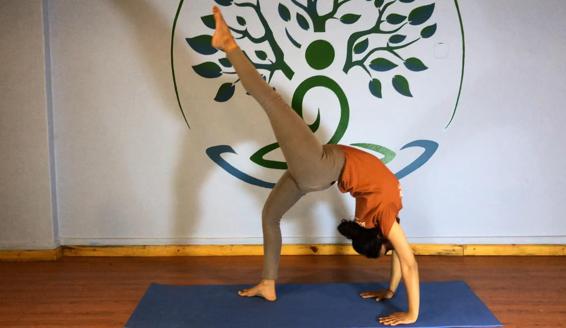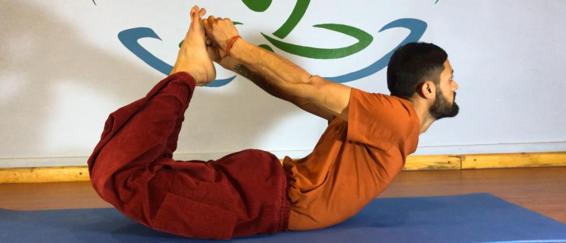3.2 Ashtanga yoga
Ashtanga yoga is a style of yoga that involves a set series of asanas that are performed in a specific order. Ashtanga yoga is physically demanding and is known for its use of vinyasa, or flowing movement, between asanas. This is also modern approach of practice. Both Ashtanga and vinyasa are relatable practice of series and similar.
Ashtanga yoga was developed by K. Pattabhi Jois, a world-renowned yoga teacher who was a student of T. Krishnamacharya, one of the pioneers of modern yoga. Ashtanga yoga is based on the principles of Hatha yoga and follows a set series of asanas, or physical postures, that are performed in a specific order.
In an Ashtanga yoga class, you can expect to practice the same sequence of asanas each time, with the goal of eventually memorizing the entire series. Ashtanga yoga is known for its use of vinyasa, or flowing movement, between asanas, and for its physically demanding nature.
Ashtanga yoga is suitable for people of all ages and fitness levels, although it is generally more physically demanding than other styles of yoga. It is important to listen to your body and modify the practice as needed to ensure that you are comfortable and safe.

In addition to its physical benefits, Ashtanga yoga also has mental benefits, as it helps to improve focus and concentration and to reduce stress and fatigue. With regular practice, Ashtanga yoga can help you to improve your physical and mental well-being and lead a happier, healthier life.
There are many different styles of Ashtanga yoga, each with its own unique approach to the practice. Some styles, such as Mysore style, involve practicing the same sequence of asanas each time, while others, such as led Ashtanga, involve a teacher leading the class through the sequence of asanas. Focus on breath and dristi or gazing internally on the movement of the postures are required in Ashtanga Vinyasa practice.
Regardless of the style of Ashtanga yoga you choose, it is important to find a qualified teacher who can guide you through the practice and help you to improve your alignment and technique. With regular practice and the guidance of a qualified
3.5 Bikram Yoga
Bikram yoga, also known as hot yoga, is a style of yoga that is practiced in a heated room. Bikram yoga is known for its physically demanding nature and is a good choice for those looking to improve their strength and flexibility.
Bikram yoga was developed by Bikram Choudhury, who was born in Calcutta India. A yoga teacher who opened the first Bikram yoga studio in Los Angeles in the 1970s.
Bikram yoga is based on the principles of Hatha yoga and follows a set series of asanas, or physical postures, that are performed in a specific order.
In a Bikram yoga class, you can expect to practice the same sequence of asanas each time, with the goal of eventually memorizing the entire series. Bikram yoga classes are held in a heated room, typically between 95 and 105 degrees Fahrenheit, and are known for their physically demanding nature.
Bikram yoga is suitable for people of all ages and fitness levels, although it is generally more physically demanding than other styles of yoga. It is important to listen to your body and modify the practice as needed to ensure that you are comfortable and safe.
In addition to its physical benefits, Bikram yoga also has mental benefits, as it helps to improve focus and concentration and to reduce stress and fatigue. With regular practice, Bikram yoga can help you to improve your physical and mental well-being and lead a happier, healthier life.
There are many different styles of Bikram yoga, each with its own unique approach to the practice. Some studios may offer variations on the traditional Bikram sequence, while others may follow the traditional sequence exactly.
Regardless of the style of Bikram yoga you choose, it is important to find a qualified teacher who can guide you through the practice and help you to improve your alignment and technique. With regular practice and the guidance of a qualified teacher, Bikram yoga can be a powerful tool for improving physical and mental well-being.
3.6 Restorative Yoga
Restorative yoga is a style of yoga that involves the use of props, such as blankets, blocks, and straps, to support the body in each asana. Restorative yoga is known for its relaxing and restful nature and is a good choice for those looking to reduce stress and improve overall well-being.
Restorative yoga was developed by the disciple of B.K.S. Iyengar, a world-renowned yoga teacher and author who has been credited with bringing yoga to the western world. Restorative yoga is based on the principles of Hatha yoga and places a strong emphasis on the use of props to support the body in each asana.
In a Restorative yoga class, you can expect to practice a variety of asanas, or physical postures, that are designed to improve flexibility, strength, and balance. Restorative yoga classes may also include pranayama, or breathing techniques, which can help to calm the mind and improve focus and concentration.
Restorative yoga is suitable for people of all ages and fitness levels, and it can be modified to meet the needs of each individual practitioner. It is important to listen to your body and modify the practice as needed to ensure that you are comfortable and safe.
In addition to its physical benefits, Restorative yoga also has mental benefits, as it helps to calm the mind and improve focus and concentration. With regular practice, Restorative yoga can help you to improve your physical and mental well-being and lead a happier, healthier life.
Restorative yoga is often taught in a series of classes, with each class building on the skills and knowledge learned in previous classes. Many Restorative yoga classes follow a set sequence of asanas, although some teachers may vary the sequence based on the needs and abilities of their students.
It is important to find a qualified Restorative yoga teacher who can guide you through the practice and help you to improve your alignment and technique. With the guidance of a qualified teacher and regular practice, Restorative yoga can be a powerful tool for improving physical and mental well-being.






